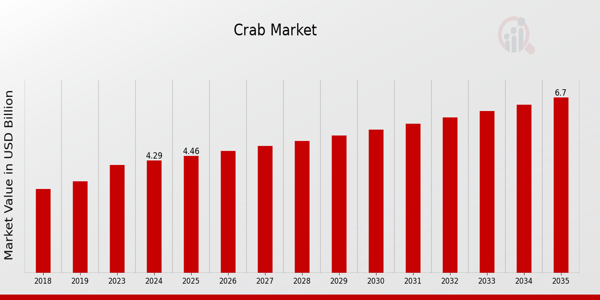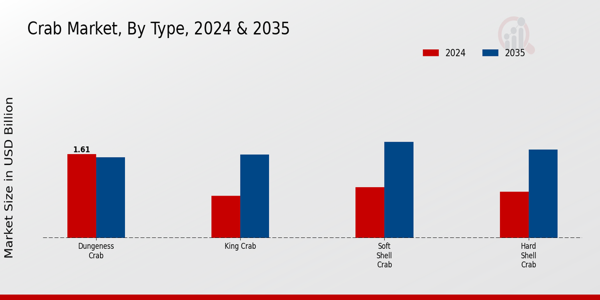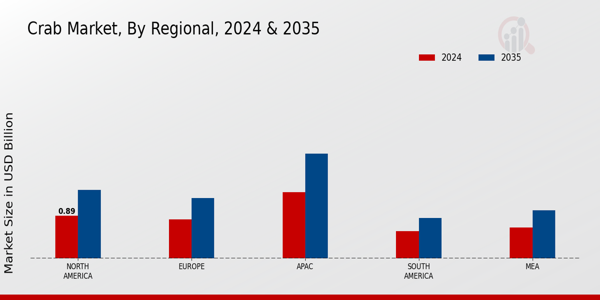Global Crab Market Overview
Crab Market Size was estimated at 4.12 (USD Billion) in 2023. The Crab Market Industry is expected to grow from 4.29(USD Billion) in 2024 to 6.7 (USD Billion) by 2035. The Crab Market CAGR (growth rate) is expected to be around 4.14% during the forecast period (2025 - 2035).

Source: Primary Research, Secondary Research, MRFR Database and Analyst Review
Key Crab Market Trends Highlighted
Significant changes in consumer preferences and growing knowledge of the health advantages of seafood are driving significant shifts in the global crab market. The increasing preference for natural and organic food sources, with crabs being valued for their high protein and low saturated fat content, is a significant element driving this industry. The growing acceptance of sustainable seafood methods, which raises demand for crab from environmentally friendly fisheries, further highlights this tendency. Initiatives to promote sustainable fishing are becoming increasingly important in influencing consumer choices in international marketplaces as environmental concerns gain traction. The growing culinary scene and the growing usage of crab in many cuisines throughout the world present an opportunity. Crab recipes are becoming increasingly common in restaurants and homes as foreign cuisines gain appeal, especially in areas where seafood is a staple. There are also more opportunities for growth in the global crab market due to the rising demand for gourmet and unique meals. It is anticipated that the rise of online food delivery services and platforms that specialize in seafood delivery will open up new avenues for more efficient customer outreach, particularly in metropolitan regions. Seasonal crab events and promotions have increased recently, and they are a successful way to increase market awareness and customer involvement.
The establishment of seafood festivals and competitions focuses on crab dishes, thus driving interest among consumers and chefs alike. The Global Crab Market must adapt to these dynamic shifts, catering to the evolving tastes and preferences of consumers while maintaining sustainable practices to secure a loyal customer base.
Crab Market Drivers
Increasing Global Demand for Seafood
The Global Crab Market Industry is experiencing robust growth primarily due to an increasing demand for seafood. In recent years, consumer awareness regarding the health benefits of seafood has amplified, with a notable shift towards high-protein diets incorporating seafood. The Food and Agriculture Organization of the United Nations has reported a consistent rise in seafood consumption worldwide, noting that global fish consumption reached approximately 20.5 kilograms per person in 2020, which is expected to increase.This surge in seafood consumption, including crabs, is driven by an expanding population and rising disposable income, particularly in developing regions. The Asian market, including countries like China and Japan, is a significant contributor to this trend, with notable economic growth driving an increase in dietary preferences for premium seafood. This growing appetite is not just limited to local consumption but also fosters a growing export market for crab products, thereby fueling the Global Crab Market Industry's growth.
Advancements in Sustainable Fishing Practices
Sustainability has become a cornerstone in the fisheries sector, directly impacting the Global Crab Market Industry. Recent innovations in sustainable fishing techniques are encouraging the responsible harvesting of crab spcies, significantly benefitting the ecosystem. Various international marine conservation organizations have been promoting certifications for sustainable fishing practices, such as the Marine Stewardship Council. An example can be found in the rise of certified sustainable crab fisheries in North America, which have seen a 30% increase in market value over the past five years due to consumer preference for sustainably sourced seafood.This trend aligns with the global movement towards sustainability, influencing consumers' buying decisions and subsequently enhancing the growth prospects of the Global Crab Market.
Rising Health Consciousness Among Consumers
Health awareness is another prominent driver for the Global Crab Market Industry. As more consumers prioritize their health and look for nutritious meal options, crab meat, which is low in fat and high in protein, has gained popularity. Recent studies suggest that the consumption of lean proteins is increasing, with approximately 30% of adults in the United States reporting they incorporate seafood into their diets regularly. This dietary shift aligns well with the rising trends in low-calorie and high-protein foods among health-conscious individuals.The demand for crab as a healthy alternative is especially strong in urban areas where lifestyle diseases like obesity and hypertension are prevalent. Influential health organizations are further promoting seafood as part of a balanced diet, driving market interest and future growth in the Global Crab Market Industry.
Crab Market Segment Insights
Crab Market Type Insights
The Global Crab Market has shown considerable growth in its various types, reflecting a rich diversity of species that appeal to consumers worldwide. In 2024, the market for Soft Shell Crab was valued at 0.973 USD Billion, and it is projected to grow to 1.85 USD Billion by 2035, indicating an increasing preference for this delicacy due to its tender texture and culinary versatility. Hard Shell Crab, valued at 0.892 USD Billion in 2024, is expected to rise to 1.7 USD Billion in 2035, underlining its significance in traditional dishes and seafood cuisines across global markets.The King Crab, known for its large size and flavorful meat, holds a market value of 0.811 USD Billion in 2024, with predictions showing growth to 1.6 USD Billion by 2035; this sub-segment not only dominates in terms of premium pricing but also draws culinary enthusiasts eager for luxury dining experiences. Meanwhile, the Dungeness Crab, although valued at 1.614 USD Billion in 2024, is projected to decline slightly to 1.55 USD Billion by 2035, highlighting a shift in consumer preferences or potential supply challenges within this sector. Each crab type contributes significantly to the overall Global Crab Market revenue, shaping the marketplace based on evolving consumer tastes and seasonal influences.The segmentation into these distinct crab types represents diverse culinary applications, economic variables, and regional availability, driving the entire Global Crab Market industry. With the rising health consciousness of consumers, particularly towards seafood that is rich in protein and omega-3 fatty acids, the demand for crab meat is likely to fuel market growth. Additionally, sustainable fishing practices are becoming increasingly important, influencing purchasing decisions and allowing certain types, like Soft Shell Crab and Hard Shell Crab, to thrive in the marketplace as they cater to an eco-conscious demographic.As competition increases and more consumers favor seafood as a healthier alternative, the significance of each crab type will shape industry standards and pricing strategies in the Global Crab Market, emphasizing the need for adaptation and innovation among producers. Global statistics reveal a positive trend in seafood consumption, indicating strong opportunities for growth and expansion across all crab types over the next decade.

Source: Primary Research, Secondary Research, MRFR Database and Analyst Review
Crab Market Source Insights
The Global Crab Market, projected to reach a valuation of 4.29 billion USD by 2024, demonstrates significant growth potential predominantly driven by the Source segmentation, which includes Wild Caught, Farmed, and Aquaculture. The Wild Caught category plays an essential role, as it appeals to consumers seeking authentic flavors and is often perceived as higher quality. On the other hand, Farmed crabs have gained traction due to advancements in sustainable aquaculture practices, meeting increasing demand while alleviating pressure on wild stocks.Aquaculture further emphasizes sustainability, showcasing a growth trend fueled by environmental concerns and consumer preferences for responsibly sourced seafood. As consumer awareness rises, the Global Crab Market revenue reflects a shift towards these sustainable practices, impacting market dynamics. An analysis of Global Crab Market metrics reveals that all source categories are responding to evolving dietary habits and environmental regulations, ultimately contributing to a balanced ecosystem within the overall industry growth. This broad segmentation enhances the Global Crab Market statistics, allowing for diverse options that cater to different consumer preferences globally.
Crab Market Form Insights
The Global Crab Market segmentation comprised of Live, Chilled, Frozen, and Canned crab products showcases the versatility and consumer preference driven by quality, convenience, and freshness. Live crab offers a premium option, appealing to gourmet chefs and upscale restaurants, while Chilled options cater to consumers seeking a fresh yet ready-to-cook alternative. Frozen crabs provide extended shelf life, making them a staple in households and food service operations worldwide.Canned crab products, known for their convenience, are significant for ready-to-eat meals and ingredient use in various culinary applications. The importance of each form reflects current market trends, with convenience and quality being key drivers for consumers. As the Global Crab Market continues to grow, the diverse forms will play a crucial role in addressing consumer demands while navigating challenges such as sustainability and supply chain management, thereby shaping market dynamics through 2035.
Crab Market Distribution Channel Insights
The Global Crab Market exhibits a diverse range of distribution channels that significantly contribute to its overall revenue. Among the various distribution avenues, supermarkets play a pivotal role by offering convenient access to seafood, catering to a large segment of the population. Online retail has emerged as a rapidly expanding channel, facilitated by changing consumer habits and the desire for home delivery, enhancing shopping convenience.Fish markets remain crucial in localities, providing fresh options and maintaining traditional purchasing habits. Specialty stores cater to niche markets and offer a variety of crab products, often including gourmet selections, which attract discerning customers. Each of these channels contributes uniquely to the Global Crab Market segmentation, enhancing consumer reach and market growth opportunities while facing challenges related to sourcing and sustainability. As the market evolves, these distribution channels will likely adapt to meet the changing preferences of consumers worldwide, reflecting the dynamic nature of the Global Crab Market industry.
Crab Market Regional Insights
The Global Crab Market is witnessing notable growth across various regions, with a projected value of 4.29 USD Billion in 2024. The North American region is a significant player, being valued at 0.892 USD Billion and expected to reach 1.424 USD Billion by 2035, reflecting a steady demand driven by seafood consumption trends. Europe follows closely with a valuation of 0.811 USD Billion in 2024, growing to 1.256 USD Billion in 2035, as the market adapts to changing consumer preferences towards healthier protein sources. The Asia-Pacific (APAC) region dominates the market, valued at 1.379 USD Billion in 2024 and expected to grow to 2.178 USD Billion, driven by an increasing population and a surge in culinary interest in crab dishes.South America, while smaller, shows significant growth potential, starting at 0.568 USD Billion in 2024 and projected to expand to 0.838 USD Billion by 2035 as coastal communities enhance their fishery practices. The Middle East and Africa (MEA) region contributes with a value of 0.641 USD Billion in 2024, with a forecast of 1.005 USD Billion by 2035, primarily influenced by rising tourism and seafood exports. The growth rates across these regions highlight varying consumption patterns and market demands, contributing dynamically to the overall Global Crab Market statistics and growth opportunities in the coming years.

Source: Primary Research, Secondary Research, MRFR Database and Analyst Review
Crab Market Key Players and Competitive Insights
The Global Crab Market is characterized by its dynamic nature, shaped by various factors such as consumer demand, environmental considerations, and advancements in sustainable fishing practices. Competitive insights reveal a landscape where product differentiation, pricing strategies, and supply chain efficiencies play crucial roles in gaining market share. Companies operating in this sector are increasingly focusing on innovative ways to attract consumers, such as developing unique crab-based products and emphasizing their sourcing practices. The demand for crab products spurred by culinary trends, health considerations, and the growing popularity of seafood is bolstered by an increasing awareness of sustainability, leading many businesses to enhance their branding around ethical and responsible fishing. Companies that navigate these intricacies effectively are well-positioned to capture a larger slice of this lucrative market.Bumble Bee Foods stands out in the Global Crab Market with a robust reputation built on a diverse portfolio and a strong focus on quality. The company leverages its longstanding history in seafood processing, offering a range of products tailored to meet the evolving tastes of consumers. The strengths of Bumble Bee Foods lie in its established supply chain networks and commitment to sustainable practices, which resonate well with current consumer trends favoring responsibly sourced seafood. Through strategic marketing and product innovation, they have cemented their presence in both retail and food service sectors. Their reputation for quality and accountability differentiates them in an increasingly competitive landscape, enabling them to maintain and expand their market share amid rising competition and fluctuating demand patterns.Rich Products Corporation plays a significant role in the Global Crab Market through its innovative approach and broad array of products. Focused on delivering high-quality offerings, the company provides various crab-based products known for their flavor and convenience. Their commitment to research and development allows for a continuous pipeline of new products that cater to consumer preferences across diverse culinary applications. Rich Products Corporation's strengths are evident in its strategic partnerships and distribution capabilities that enhance its market presence on a global scale. The company has engaged in mergers and acquisitions to bolster its product lineup and expand its market access, ensuring a competitive stance within the global seafood industry. This adaptability, combined with a focus on quality and customer satisfaction, positions Rich Products Corporation as a formidable player in the Global Crab Market.
Key Companies in the Crab Market Include
- Bumble Bee Foods
- Rich Products Corporation
- Maruha Nichiro Corporation
- Austevoll Seafood ASA
- Pacific Seafood Group
- High Liner Foods
- Trident Seafood Corporation
- Pacific Rich Holdings
- Sea Harvest Corporation
- Brunswick Corporation
- Igloo Foods
- Hokkaido Seafood
- Adriatic Fish Company
- Crown Prince Inc
- Blue Star Foods
Crab Market Industry Developments
The Global Crab Market has seen significant developments and fluctuations recently. In October 2023, Bloomberg reported strong growth for companies such as Bumble Bee Foods and Trident Seafood Corporation as demand for crab continues to rise globally. Meanwhile, Rich Products Corporation and High Liner Foods are actively expanding their product lines to meet consumer preferences for sustainable seafood. In terms of mergers and acquisitions, Austevoll Seafood ASA announced the acquisition of a regional crab processing company in September 2023 to enhance its market positioning. Furthermore, in August 2023, Pacific Seafood Group acquired specific assets from Hokkaido Seafood to broaden its footprint in the Asian market. The market has experienced considerable growth, with valuation expected to surpass USD 15 billion by 2024, driven largely by increased demand from both retail and food service sectors. Additionally, regulatory developments concerning sustainability practices have influenced operations across major players like Sea Harvest Corporation and Pacific Rich Holdings. The past two years have been marked by technological advancements in fishing and processing, alongside innovative product offerings that cater to the growing preference for premium seafood options among consumers globally.
Crab Market Segmentation Insights
- Crab Market Type Outlook
- Soft Shell Crab
- Hard Shell Crab
- King Crab
- Dungeness Crab
- Crab Market Source Outlook
- Wild Caught
- Farmed
- Aquaculture
- Crab Market Form Outlook
- Live
- Chilled
- Frozen
- Canned
- Crab Market Distribution Channel Outlook
- Supermarkets
- Online Retail
- Fish Markets
- Specialty Stores
- Crab Market Regional Outlook
- North America
- Europe
- South America
- Asia Pacific
- Middle East and Africa
Report Scope:
| Report Attribute/Metric Source: |
Details |
| MARKET SIZE 2023 |
4.12(USD Billion) |
| MARKET SIZE 2024 |
4.29(USD Billion) |
| MARKET SIZE 2035 |
6.7(USD Billion) |
| COMPOUND ANNUAL GROWTH RATE (CAGR) |
4.14% (2025 - 2035) |
| REPORT COVERAGE |
Revenue Forecast, Competitive Landscape, Growth Factors, and Trends |
| BASE YEAR |
2024 |
| MARKET FORECAST PERIOD |
2025 - 2035 |
| HISTORICAL DATA |
2019 - 2024 |
| MARKET FORECAST UNITS |
USD Billion |
| KEY COMPANIES PROFILED |
Bumble Bee Foods, Rich Products Corporation, Maruha Nichiro Corporation, Austevoll Seafood ASA, Pacific Seafood Group, High Liner Foods, Trident Seafood Corporation, Pacific Rich Holdings, Sea Harvest Corporation, Brunswick Corporation, Igloo Foods, Hokkaido Seafood, Adriatic Fish Company, Crown Prince Inc, Blue Star Foods |
| SEGMENTS COVERED |
Type, Source, Form, Distribution Channel, Regional |
| KEY MARKET OPPORTUNITIES |
Sustainable crab farming initiatives, E-commerce seafood sales growth, Premium crab product offerings, Increased health consciousness trends, Expansion in Asian markets |
| KEY MARKET DYNAMICS |
Rising consumer demand, Sustainable fishing practices, Import regulations and tariffs, Price volatility, Flavor and quality preferences |
| COUNTRIES COVERED |
North America, Europe, APAC, South America, MEA |
Frequently Asked Questions (FAQ) :
The Global Crab Market is expected to be valued at 4.29 billion USD in 2024.
By 2035, the Global Crab Market is projected to reach a value of 6.7 billion USD.
The Global Crab Market is expected to grow at a CAGR of 4.14% from 2025 to 2035.
The APAC region is forecasted to have the largest market size in 2024, valued at 1.379 billion USD.
The North American Crab Market is expected to be valued at 1.424 billion USD by 2035.
The Dungeness Crab is projected to reach a market value of 1.55 billion USD by 2035.
The estimated market size for Soft Shell Crab in 2024 is 0.973 billion USD.
Major players in the Global Crab Market include Bumble Bee Foods, Rich Products Corporation, and Pacific Seafood Group.
Challenges impacting the Global Crab Market include fluctuating supply and changing consumer preferences.
Emerging players can explore opportunities in product innovation and expanding into untapped regional markets.

















